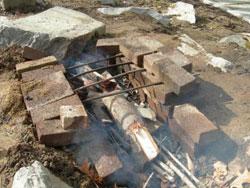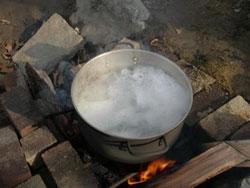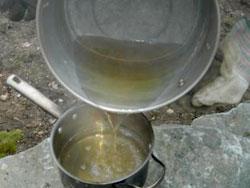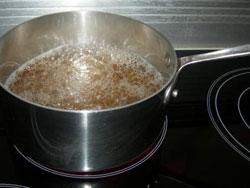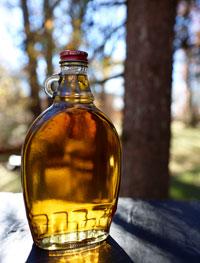Transfer sap from buckets to storage containers
Use only food grade containers to store your collected sap. Clean plastic milk jugs or juice containers may be used. You can also use 5 gallon buckets (food grade quality). Your local deli or donut shop may provide these free of charge, as they often receive their ingredients in these containers. Be sure all containers are thoroughly cleaned using a mixture of one part unscented household bleach (such as Clorox® Regular-Bleach) to 20 parts clean water. Scrub the containers and triple rinse with hot water.
When sap is flowing, collect the sap daily. Pour the sap from the bucket into a storage container, using cheesecloth to filter out any foreign material. If a portion of the sap is frozen, throw away the frozen sap.
Storing your sap
The sap should be stored at a temperature of 38 degrees F or colder, used within 7 days of collection and boiled prior to use to eliminate any possible bacteria growth. If there is still snow on the ground, you may keep the storage containers outside, located in the shade, and packed with snow. You can also store the sap in your refrigerator, or for longer term storage, in your freezer. Remember that sap is like milk, it will spoil quickly if not kept cold.
Process sap into maple syrup and other uses
Treat sap like any other nutrient taken directly from nature to include in your diet. When you pick berries in a field, they can be eaten directly from the bush; however, it is generally a good idea to wash them first. Many drink sap straight from the collection bucket, but it is highly recommended you boil your sap prior to any use to kill bacteria that may be present. To effectively kill bacteria, bring the sap to a rolling boil and then let it boil one additional minute.
Maple Sap: Many believe that drinking maple sap is a way to energize the body after a long winter. In South Korea, the drinking of sap is linked to a wide range of health benefits. Here is an interesting NY Times article about the use of maple sap in South Korea. Maple sap can also be used to make coffee / tea, brew beer, and in just about any recipe calling for water (to add a subtle sweet, maple flavor).
Maple Syrup: The most common use of maple sap is to process it into maple syrup. To make maple syrup, the excess water is boiled from the sap. It takes 40 parts maple sap to make 1 part maple syrup (10 gallons sap to make 1 quart syrup). Because of the large quantity of steam generated by boiling sap, it is not recommended to boil indoors. If you do decide to boil the sap indoors, make only small batches and ensure good ventilation (and keep an eye that your wallpaper does not peel off the walls). If you boil outdoors, make certain you are in compliance with any local regulations. Fire safety must be your highest priority, especially when young children are present. Below is one method for boiling your sap.
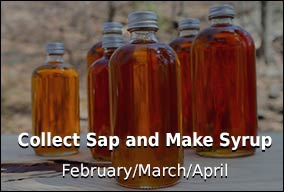 Depending upon the weather conditions, sap will start to flow immediately after tapping the tree. It drips from the spile into the bucket. Maple sap is a clear fluid and resembles water. The collection amount may vary. Some days you will collect only a small amount and other days your buckets will overflow if not emptied.
Depending upon the weather conditions, sap will start to flow immediately after tapping the tree. It drips from the spile into the bucket. Maple sap is a clear fluid and resembles water. The collection amount may vary. Some days you will collect only a small amount and other days your buckets will overflow if not emptied.

